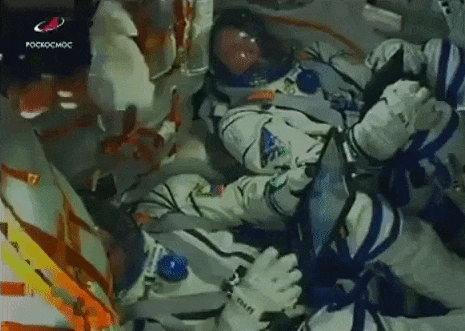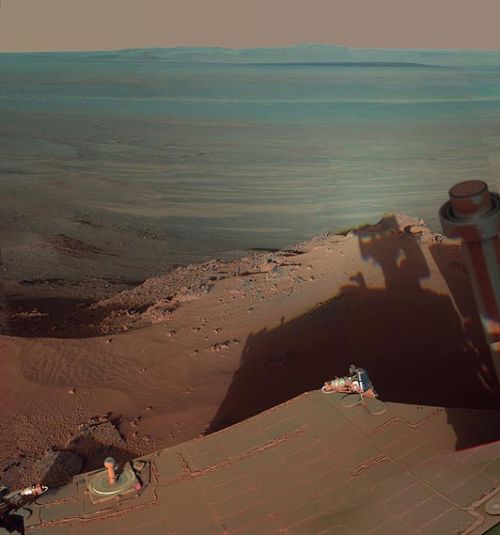Fillthevoid-with-space - Fill The Void With... SPACE

More Posts from Fillthevoid-with-space and Others

Light Echoes Used to Study Protoplanetary Disks : This illustration shows a star surrounded by a protoplanetary disk. A new study uses data from NASAs Spitzer Space Telescope and four ground-based telescopes to determine the distance from a star to the inner rim of its surrounding protoplanetary disk. Researchers used a method called photo-reverberation, also known as light echoes.
js

New Zealand was lovely, but I already touched on what I’d be tempted to talk about with my Southern Stars episode. A person I interviewed as a potential new housemate gave me the idea for this episode because the joy of outer space is truly everywhere and anywhere. The field of astrogeology was not something I had heard of before, though I had indirectly heard of Eugene Shoemaker. I knew the comet Shoemaker-Levy 9 was named after him (and Carolyn Shoemaker, his wife). It turns out he basically founded the modern field of astrogeology! So I talk about him for quite a while, too.
Below the cut are the glossary, transcript, sources, and music credits. Send me any topic suggestions via Tumblr message (you don’t need an account to do this, just submit as anonymous). You can also tweet at me on Twitter at @HDandtheVoid, or you can ask me to my face if you know me in real life. Subscribe on iTunes to get the new episodes of my semi-monthly podcast, and please please please rate and review it. Go ahead and tell friends if you think they’d like to hear it, too!
(The next episode is definitely going to be on famous comets, and I’m hoping to publish that episode in May.)
Glossary
active galaxy - a galaxy with a small core of emission embedded at the center. This core is typically very variable and very bright compared to the rest of the galaxy. These galaxies emit much more energy than they should; this excess energy is found in the infrared, radio, UV, and X-ray regions of the electromagnetic spectrum.
black hole - a region of spacetime where a great deal of mass and energy have been compressed into a relatively small space. Black holes exert such strong gravitational effects that no mass or energy, not even light, can escape from inside them. There are supermassive black holes in galaxies that contribute to the development and life cycle of galaxies.
blazar - a subcategory of active galaxy, it is an extremely bright, distant object, powered by a black hole, which emits massive amounts of energy. It is distinct from a quasar because it is even brighter.
interferometry - a group of techniques to extract information from superimposing electromagnetic waves to create interference. In radio astronomy, this is done by using a wide spread of receivers to look at the same distant object, then bringing that data together with a correlator that can create a larger, clearer picture than an individual radio telescope alone could.
Messier object - a deep-sky object included on a list of 103-110 deep-sky objects made by Charles Messier and his colleagues in the 18th century in an attempt to prevent fuzzy, bright objects from being confused with comets.
torus - a donut shape.
quasar - a distant, massive celestial object that emits extremely large amounts of energy. These star-like objects may reflect a stage in the evolution of some galaxies.
Script/Transcript
Sources
Black Holes, explained via National Geographic
What Is a Black Hole? via NASA
Black Holes via NASA
Black Hole via Swinburne University of Technology
Darkness Visible, Finally: Astronomers Capture First Ever Image of a Black Hole via the New York Times (April 2019)
Event Horizon Telescope
Astronomers Capture First Image of a Black Hole via ESO (April 2019)
How They Took the First Picture of a Black Hole via New York Times (April 2019)
Intro Music: ‘Better Times Will Come’ by No Luck Club off their album Prosperity
Filler Music: ‘Flame On Flame (A Slow Dirge)’ by Kishi Bashi off his album Sonderlust
Outro Music: ‘Fields of Russia’ by Mutefish off their album On Draught

First Female U.S. Astronaut, Sally Ride, Comes Out In Obituary | BuzzFeed
“I hope it makes it easier for kids growing up gay that they know that another one of their heroes was like them,” Sally Ride’s sister, Bear Ride, said.

Soyuz MS-10 experiences launch anomaly; crew aborts to safe landing.
One of Russia’s most reliable launchers experienced a rare, in-flight anomaly earlier this morning, forcing the two-man crew of Soyuz MS-10 to abort the mission.
Following a normal liftoff at 4:40am EST (2:40pm local time), a malfunction in the Soyuz FG rocket two minutes into the flight forced Expedition 57 crewmembers Alexey Ovchinin and Nick Hague to abort a manual abort profile. The anomaly occurred immediately following the separation of the rocket’s four strap-on boosters and jettisoning of the Launch Escape System. However, the protective fairing covering the spacecraft during flight through the thick atmosphere was still on, and solid rocket motors attached to the fairing pulled the crew capsule away from the failing booster. Following a ballistic trajectory through the upper atmosphere, the Soyuz’s Descent module separated from the Orbital Module and payload fairing and descended to a safe landing 20 kilometers east of Zezkezhan, Kazakhstan, 34 minutes after launch. Roscosmos reported that the crewmembers experienced around seven times the force of gravity, or 7G’s, during their abort.
Recovery forces reached the landing site immediately following touchdown. Both astronauts were reported to be in good health following their ordeal, and returned to their families at the Baikonur launch site around six hours after liftoff.

Recovery forces at the Soyuz MS-10 emergency landing site. Source: Ruptly.

Soyuz MS-10 crewmembers Alexey Ovchinin and Nick Hague embrace their families following their return to the Baikonur Cosmodrome after today’s launch mishap. Credit: NASA/Bill Ingalls. This marks the first crewed launch mishap of the International Space Station program, the first crewed launch mishap since the Challenger disaster in 1986, and the first crewed Soyuz launch malfunction since Soyuz T-10 in 1983.
That incident saw the two-man crew of Vladimir Titov and Gennady Strekalov abort away from their exploding rocket shortly before its scheduled liftoff time. While no cause of the mishap is currently known, Russian authorities have begun an investigation of the incident and have temporarily grounded all future Soyuz flights. The current three-member crew of Expedition 57 is slated to return to Earth December 13, followed by the launch of Expedition 58 December 20. Following today’s anomaly, it is unclear whether Expedition 57 will remain on orbit longer, or when the next crew will launch to the station. Expedition 57 is able to remain on orbit until early January, when their Soyuz reaches its certified orbital lifetime.

Expedition 57 commander Alexander Gerst captured this image of the Soyuz MS-10 launch from the International Space Station. The anomalous nature of the launch is evidenced by multiple points of light along the ascent path. Source: NASA. Watch NASA TV coverage of the Soyuz MS-10 launch below.
P/c: NASA.
Here’s a great example of the kinds of experiments astronauts perform on the International Space Station, just like I talked about in Episode 19! I absolutely want to high-five whoever called is ISS-CREAM.
From Frozen Antarctica to the Cold Vacuum of Space
A new experiment that will collect tiny charged particles known as galactic cosmic rays will soon be added to the International Space Station. The Cosmic Ray Energetics And Mass for the International Space Station payload, nicknamed ISS-CREAM, will soon be installed in its new home on the Station’s Japanese Experiment Module Exposed Facility. ISS-CREAM will help scientists understand more about galactic cosmic rays and the processes that produce them.

Wait, what are cosmic rays?
Cosmic rays are pieces of atoms that move through space at nearly the speed of light. Galactic cosmic rays come from beyond our solar system.

They provide us with direct samples of matter from distant places in our galaxy.
Why do these things go so fast?
Galactic cosmic rays have been sped up by extreme processes. When massive stars die, they explode as supernovas. The explosion’s blast wave expands into space along with a cloud of debris.

Particles caught up in this blast wave can bounce around in it and slowly pick up speed. Eventually they move so fast they can escape the blast wave and race away as a cosmic ray.
Where can we catch cosmic rays?
Cosmic rays are constantly zipping through space at these super-fast speeds, running into whatever is in their path – including Earth.

But Earth’s atmosphere is a great shield, protecting us from 99.9 percent of the radiation coming from space, including most cosmic rays. This is good news for life on Earth, but bad news for scientists studying cosmic rays.
So… how do you deal with that?
Because Earth has such an effective shield against cosmic rays, the best place for scientists to study them is above our atmosphere – in space. Since the 1920s, scientists have tried to get their instruments as close to space as possible. One of the simplest ways to do this is to send these instruments up on balloons the size of football stadiums. These balloons are so large because they have to be able to both lift their own weight and that of their cargo, which can be heavier than a car. Scientific balloons fly to 120,000 feet or more above the ground – that’s at least three times higher than you might fly in a commercial airplane!

Credit: Isaac Mognet (Pennsylvania State University)
Earlier versions of ISS-CREAM’s instruments were launched on these giant balloons from McMurdo Station in Antarctica seven times, starting in 2004, for a total of 191 days near the top of the atmosphere. Each of these flights helped the team test their hardware and work towards sending a cutting-edge cosmic ray detector into space!
How is going to space different than flying balloons?
Balloon flights allowed the team to collect a lot of cosmic rays, but even at 120,000 feet, a lot of the particles are still blocked. Scientists at the University of Maryland, College Park, who operate ISS-CREAM, expect to get about 10 times as much data from their new home on the International Space Station.

That’s because it will be both above the atmosphere and fly far longer than is possible with a balloon. As you might imagine, there are large differences between flying something on a balloon and launching it into space. The science instruments and other systems had to be changed so ISS-CREAM could safely launch on a rocket and work in space.
What will ISS-CREAM do?
While on the space station, ISS-CREAM will collect millions of cosmic rays – electrons, protons and atomic nuclei representing the elements found in the solar system. These results will help us understand why cosmic rays reach the wicked-fast speeds they do and, most important, what limits those speeds.
ISS-CREAM launches to the International Space Station aboard the latest SpaceX Dragon spacecraft, targeted to launch August 14. Want to learn more about ISS-CREAM and some of our scientific balloons? Check out our recent feature, NASA’s Scientific Balloon Program Reaches New Heights.
Make sure to follow us on Tumblr for your regular dose of space: http://nasa.tumblr.com






Sharpest View of the Andromeda Galaxy, Ever.
The NASA/ESA Hubble Space Telescope has captured the sharpest and biggest image ever taken of the Andromeda galaxy — a whopping 69,536 x 22,230 pixels. The enormous image is the biggest Hubble image ever released and shows over 100 million stars and thousands of star clusters embedded in a section of the galaxy’s pancake-shaped disc stretching across over 40,000 light-years.
Use the ZOOM TOOL to view in full detail.
(WARNING: May cause existential crisis)

A Giant Star Factory in Neighboring Galaxy NGC 6822 NASA
js
The United Launch Alliance’s Atlas V rocket carrying the Orbital ATK Cygnus module rolls to Cape Canaveral Air Force Station’s Launch Pad 41 in this time-lapse video. The rollout is in preparation for the Orbital ATK CRS-7 mission to deliver supplies to the International Space Station.
Launch is currently scheduled for 11:11 a.m. EDT, watch live coverage: http://www.nasa.gov/live
Make sure to follow us on Tumblr for your regular dose of space: http://nasa.tumblr.com
-
 danny-cartwright liked this · 1 year ago
danny-cartwright liked this · 1 year ago -
 tolookbeyondtheglory liked this · 1 year ago
tolookbeyondtheglory liked this · 1 year ago -
 chaotic-starlight24 liked this · 1 year ago
chaotic-starlight24 liked this · 1 year ago -
 coeur-dacier liked this · 2 years ago
coeur-dacier liked this · 2 years ago -
 cashthecomposer liked this · 2 years ago
cashthecomposer liked this · 2 years ago -
 enpr-ss reblogged this · 2 years ago
enpr-ss reblogged this · 2 years ago -
 enpr-ss liked this · 2 years ago
enpr-ss liked this · 2 years ago -
 riverwithoutbanks liked this · 2 years ago
riverwithoutbanks liked this · 2 years ago -
 goodyp liked this · 3 years ago
goodyp liked this · 3 years ago -
 liberinamorata liked this · 3 years ago
liberinamorata liked this · 3 years ago -
 doomdog101 reblogged this · 3 years ago
doomdog101 reblogged this · 3 years ago -
 doomdog101 liked this · 3 years ago
doomdog101 liked this · 3 years ago -
 idontknowitsdigiorno liked this · 3 years ago
idontknowitsdigiorno liked this · 3 years ago -
 diapasondame liked this · 3 years ago
diapasondame liked this · 3 years ago -
 redwinterbloom liked this · 3 years ago
redwinterbloom liked this · 3 years ago -
 thelittlestcat liked this · 3 years ago
thelittlestcat liked this · 3 years ago -
 therealmaeel liked this · 3 years ago
therealmaeel liked this · 3 years ago -
 batmeringue liked this · 3 years ago
batmeringue liked this · 3 years ago -
 autistic-stare liked this · 4 years ago
autistic-stare liked this · 4 years ago -
 thatminecraftgal liked this · 4 years ago
thatminecraftgal liked this · 4 years ago -
 clementines-and-cuties liked this · 4 years ago
clementines-and-cuties liked this · 4 years ago -
 moonrisebooksandesoterica liked this · 4 years ago
moonrisebooksandesoterica liked this · 4 years ago -
 i-liek-chocolate-milk liked this · 4 years ago
i-liek-chocolate-milk liked this · 4 years ago -
 arsrey liked this · 4 years ago
arsrey liked this · 4 years ago -
 ourariadis liked this · 4 years ago
ourariadis liked this · 4 years ago -
 star-jack liked this · 4 years ago
star-jack liked this · 4 years ago -
 roxanne-in-prison reblogged this · 4 years ago
roxanne-in-prison reblogged this · 4 years ago -
 roxanne-in-prison liked this · 4 years ago
roxanne-in-prison liked this · 4 years ago -
 spooky-scary-sandwich liked this · 4 years ago
spooky-scary-sandwich liked this · 4 years ago -
 tooweirdfortheworld liked this · 4 years ago
tooweirdfortheworld liked this · 4 years ago -
 rainingmoondrops reblogged this · 4 years ago
rainingmoondrops reblogged this · 4 years ago -
 rainingmoondrops liked this · 4 years ago
rainingmoondrops liked this · 4 years ago -
 benerdcomics liked this · 4 years ago
benerdcomics liked this · 4 years ago -
 aaronshitposts liked this · 4 years ago
aaronshitposts liked this · 4 years ago -
 what-do-life-is liked this · 4 years ago
what-do-life-is liked this · 4 years ago -
 yellowteethandchickenfeet liked this · 4 years ago
yellowteethandchickenfeet liked this · 4 years ago -
 hildegard-von-bloggen liked this · 4 years ago
hildegard-von-bloggen liked this · 4 years ago -
 toastedhunny liked this · 4 years ago
toastedhunny liked this · 4 years ago -
 traveling-while-we-are-alive liked this · 4 years ago
traveling-while-we-are-alive liked this · 4 years ago -
 vaindumbass liked this · 5 years ago
vaindumbass liked this · 5 years ago -
 lovethellamas liked this · 5 years ago
lovethellamas liked this · 5 years ago -
 projecthopep3 liked this · 5 years ago
projecthopep3 liked this · 5 years ago -
 morgast liked this · 5 years ago
morgast liked this · 5 years ago -
 nervousnumbat liked this · 5 years ago
nervousnumbat liked this · 5 years ago -
 arcfallens liked this · 5 years ago
arcfallens liked this · 5 years ago
A podcast project to fill the space in my heart and my time that used to be filled with academic research. In 2018, that space gets filled with... MORE SPACE! Cheerfully researched, painstakingly edited, informal as hell, definitely worth everyone's time.
243 posts









